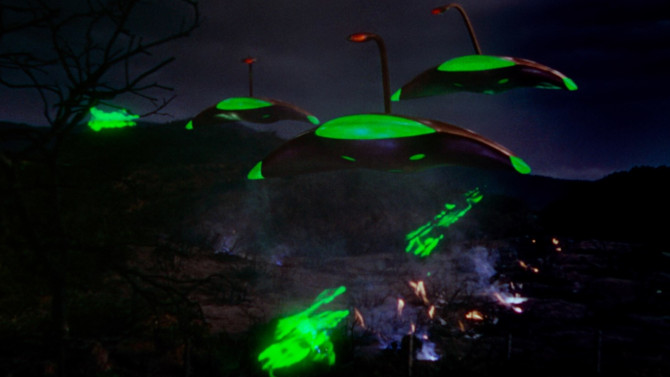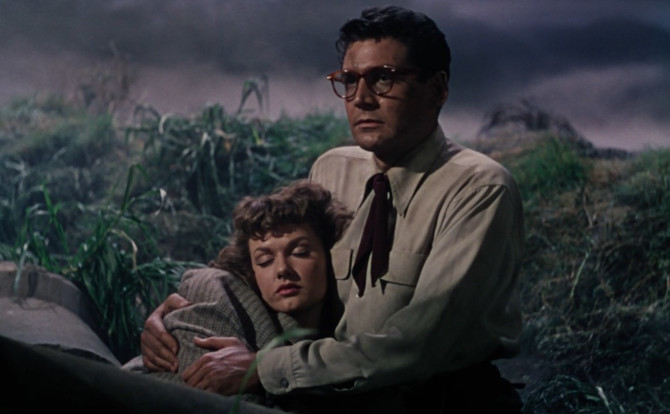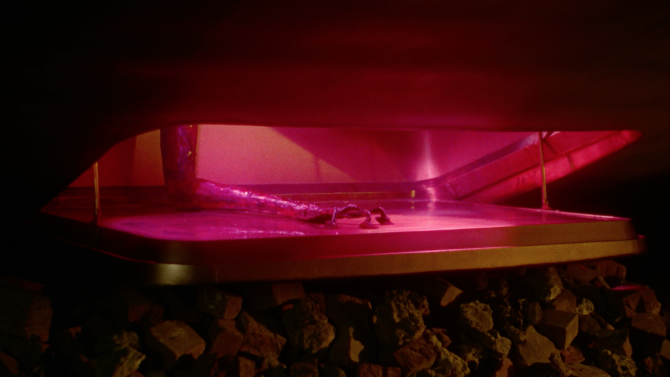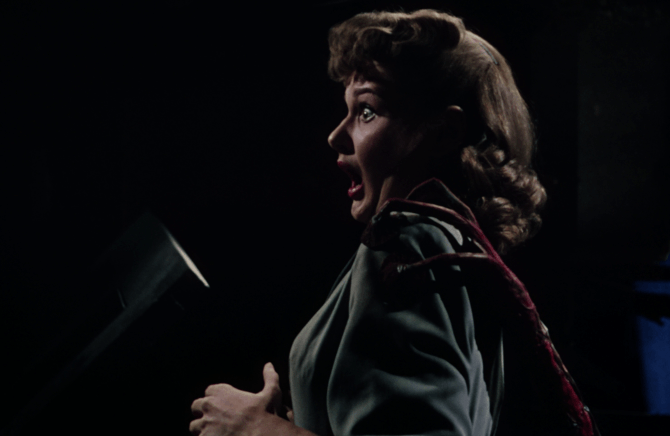Talk about a buildup. . . starting with the First World War, then came the Second World War, it all leading to. . . The War of the Worlds!!! A gargantuan and ballsy way to introduce your film, these black and white reels from the first half of the twentieth century give way to garish colours of the Atomic Age in Byron Haskin’s modernized 1953 take on the iconic H.G. Wells novel.
Controlled by ambitious producer George Pal (who both produced and directed The Time Machine), he obtained the material after it sat on legendary director Cecil B. DeMille’s desk for some three decades (it was always a dream project for him). Bringing in a talented team of creative individuals, it was longtime special effects man turned director Byron Haskin who was his choice.
With a goal of transforming what would normally be a cheesy B quality drive-in picture, into an Oscar worthy, A list, grand theatre screened feature, he had Barré Lyndon (Night Has a Thousand Eyes) update it from a Victorian era British story, to a modern day tale that encompassed the themes on the minds of an entire planet.
Set during the Cold War in a small town just south of Los Angeles, the fear and paranoia of the early Atomic Age is palpable. . . people look to the skies not for inspiration from the stars, but rather, out of fear of a possible nuclear bomb. Narrated by Sir Cedric Hardwicke, his rich British cadence a nice nod to the novel’s original setting, we are drawn into the lives of a soon to be couple, scientist Dr. Clayton Forrester (Gene Barry), who just so happens to be enjoying some r&r when the mysterious ball falls from the sky, and a young woman, Sylvia Van Buren (Ann Robinson) – who ironically has spent much of the past few years reading through Forrester’s academic articles as she completed her Masters.
At first thought to be some sort of asteroid, the people of this small, sleepy little town soon learn that something much darker hides inside. . . an advanced alien species from Mars, hell bent on conquering the entire planet. Rallying the local military, they are led by Maj. Gen. Mann (Les Tremayne), a confident man who, despite being rebuffed by the superior technology of the encroaching species, never gives up.
Eventually leading to the doorstep of Los Angeles, can the military do anything to stop these technologically advanced intruders? Can Forrester and Van Buren, with their scientific minds, devise some sort of plan to combat these Martians? Might a white flag, waved in surrender here, be an aggravating insult on the Red Planet? And, perhaps most importantly, can love keep us together. . . especially in the wake of impending death?
A masterpiece of visual splendour, its combination of colourful creativity and human ingenuity is breathtaking. Cinematographer George Barnes (known for his black and white work – he won an Oscar for Rebecca. . . rarely dabbling with coloured films), uses the Technicolor process in a most impressive way, making the screen pop with a rich Atomic Age palette. Almost like Day-Glo inks, its fluorescent pigmentation makes the garish reds and greens glow in the dark (in a most alien way), while his work with shadow and light harkens back to his talent with non-colour films. It deserves a prominent place along with the likes of The Wizard of Oz, Gone With the Wind, The Red Shoes, and Vertigo (to name but a few) atop the list of great Technicolor masterpieces of all-time.
This, combined with the forward-thinking visual effects, really makes the piece. Opening with some impressive matte paintings of the other planets in our solar system (with some miniature effects to add dimension. . . the paintings were done by Chesley Bonestell), the audience knows it’s in for some spectacular sights. Always subverting expectations in a most original way, you won’t find any cheesy flying saucers in this feature, rather, a sleek, futuristic design by Al Nozaki (who a decade or so earlier knew what an invasion felt like, for he was interned along with many other Japanese Americans during World War 2) – his design still an influence and inspiration to this day. Featuring a sweeping periscope heat ray weapon with a searching eye, two green skeleton beams coming from the sides, and an invisible force field that is only seen when it blocks an attack, it really is impressive. Made out of copper, the only way at the time to make things look realistic, was to create giant miniatures (something Peter Jackson would use nearly five decades later for The Lord of the Rings trilogy) of the cities and countryside. . . and boy is it sharp. In fact, some of the most unbelievable aspects (the green rays) find Tesla-like controlled electricity being blown with fans. A similar process was used when they began developing electric beams that would allow the spacecrafts to float, but it was a major fire hazard and they had to abandon the process (it can only be seen when the vehicle rises for the first time).
An equal amount can be said for the film’s influence on sound design. . . with many of the effects being reused in future productions (including the sound for the green rays being used as the photon torpedo in the original Star Trek series). In fact, traditional instruments, the new electric guitar, a woman screaming played backwards, a microphone rubbing on dry ice, and the hissing of a tape’s feedback are just a few examples of what was used to develop what we hear in the movie. And all of this is complemented by Leith Stevens’ pitch perfect score.
Winning an Academy Award for Best Visual Effects, The War of the Worlds is one of the preeminent science fiction films of the 1950s. Influential in every which way, its combination of Cold War themes, newfound excitement in space exploration, and alien intrigue at the time, when mixed with its progressive effects and quality story, elevated the genre, also bringing with it a number of movies looking to capitalize on its success. So, remember that this is no microbe in the cinematic reels of history, it is a superbug that ended up influencing an age of improved effects and quality science fiction pictures.





